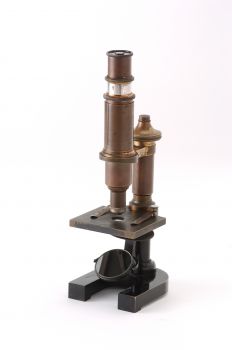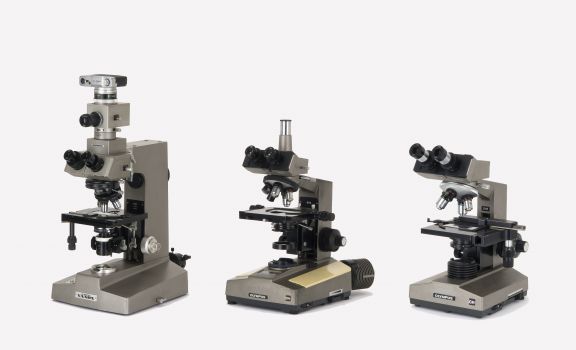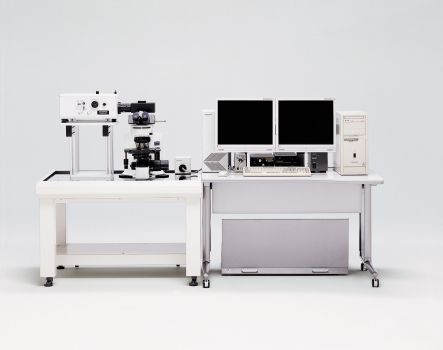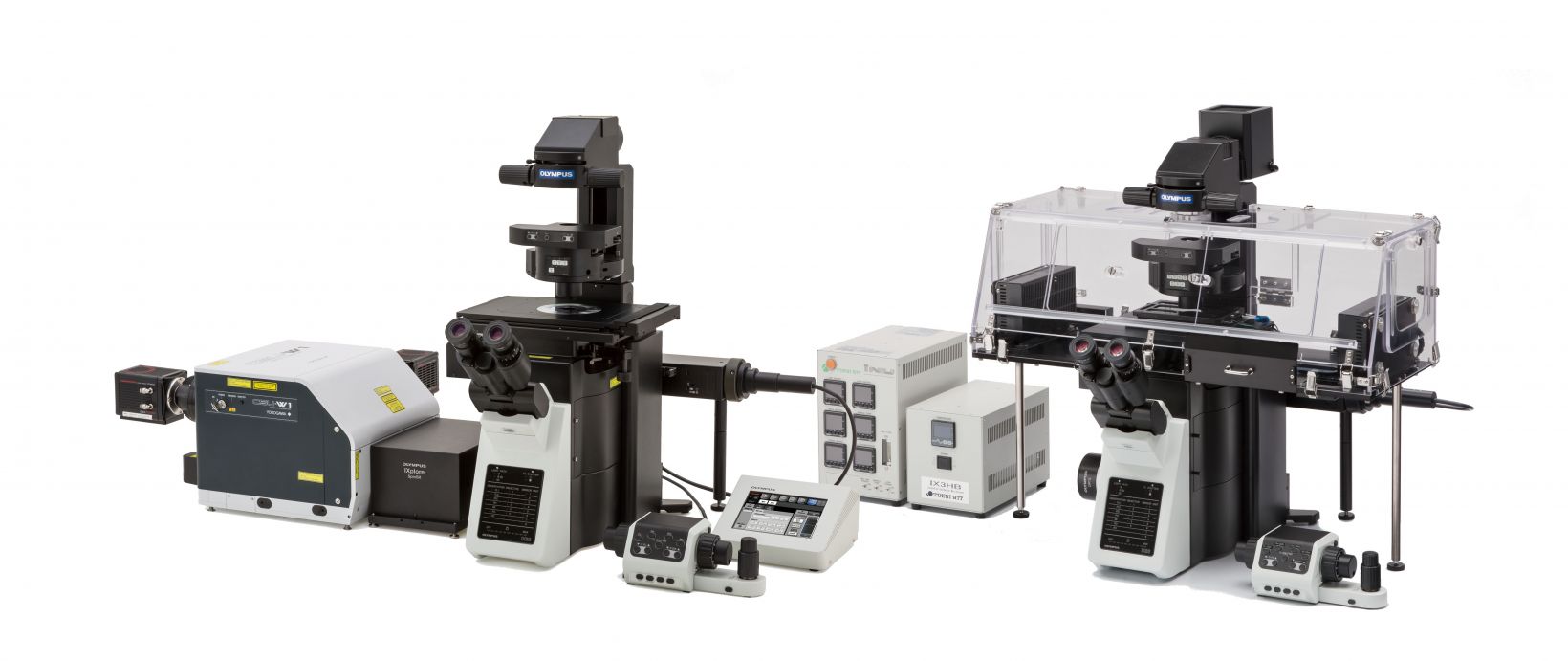The Spirit of Creation: Milestones in Microscopy
A Century of Creation
Throughout three decades of struggle, exacerbated by the Great Kanto Earthquake and World War II, Yamashita led Olympus in innovating award-winning microscopes to help advance life science research and practice. Immediately following World War II, the business flourished, and we became one of the first companies to resume its post-war factory operations and make a move toward modernization.
While there have been many innovation milestones in Olympus’ 100-year history, our mission has always been driven by Takeshi Yamashita’s original vision, to “create something truly original and bring value to society.”
100 Years of Optical Innovation
In 1950, Olympus made a breakthrough that benefitted clinical medicine, using our growing expertise in optics to develop the world’s first gastrocamera. This invention also established our entry into the endoscopy business. Throughout the 1960s, Olympus became one of the industry’s preeminent integrated optical manufacturers. All the while, we continued working diligently to improve our products’ ease of use and increase their functionality, focusing intently on customer needs. In the 1970s, to meet the evolving demands of the microscope industry, Olympus developed three upright microscope series targeting specific applications, including research (AH series), clinical laboratory (BH series), and education (CH series).
A platform, or main body, was designed for the flagship of these series, the VANOX AH microscope. This platform was used as the base for subsequent models in the AH series, as well as BH and CH models. The needs of different applications could be met simply by changing the model’s components.
With multipurpose BH microscopes, users could switch the head or lens to change the observation method. Options included polarization, phase contrast, differential interference, and simple transmission fluorescence microscopy. BH microscopes were forerunners of the BX microscope series, which is still around today.
Designed for teaching purposes, the modular design of the CH series—enabling simple polarization, drawing, or epi-illumination (metallurgical) microscopy—made these products particularly well-suited for biological research and use in the clinical laboratory.
100 Years of Customer-Focused Advances
In the 1980s, Olympus incorporated an autofocus (AF) function into the high-performance AH-2 series microscopes. At the time, this AF feature was advanced technology. A motorized mechanism automatically set the microscope’s field stop, aperture stop, and condenser selection based on the objective lens’ magnification and brightness. This was a big leap forward in microscope usability. With the focus taken care of, users were able to concentrate on observation.
This decade also saw the advent of configurable microscope systems, such as the BH2 series. The BH2 microscope’s long barrel (LB) objective lenses (1X–100X oil) could be used for brightfield, polarization, fluorescence, and phase contrast microscopy. This functionality paved the way for the SZH high-end stereo microscope, a successor of the award-winning SZ microscope.
100 Years of Technological Evolution
During the 1980s and 90s, advances in fluorescent protein labeling, culminating in the application of green fluorescent protein (GFP) for live cell imaging, spurred product development. GFP revealed dynamic processes inside living cells that were previously invisible. This meant that life sciences researchers required observation techniques with higher sensitivity and lower phototoxicity.
This period also saw rapid advances in digital technology. With the computer revolution in full swing, product development in many industries benefited from automation facilitated by microprocessors, CPUs, GPUs, and digital memory.
In the 1990s, two significant life science series were launched, the FLUOVIEW® microscope series and the DP® microscope-dedicated digital camera series. FLUOVIEW laser scanning confocal microscopes scanned with an excitation laser, selectively acquiring sectioned layers of the sample to produce 3D images. These series were cornerstones in Olympus’ range of products aimed at meeting the demands of high-end life science research.
100 Years of Dedication to Image Quality
In keeping with our unwavering pursuit of the highest-quality image for our customers, Olympus developed and launched a line of universal infinity system (UIS) objectives. UIS optics not only greatly improved the quality of observation images, but also universalized the objectives used for all Olympus microscopes. Introduced in the early 90s, these optics were initially used in the AX, BX, and CX microscope series and subsequently the FLUOVIEW series.
About ten years later, the next generation UIS2 series objectives were released along with the BX® upright microscope and IX® inverted research microscope. Still popular today, UIS2 objectives provide clear, high-resolution images, low autofluorescence, and a longer-wavelength capability. The eyepieces offer higher transparency and are made with lead-free glass, so they are more environmentally friendly.
The early 2000s were marked by the launch of a twin-laser scanning FLUOVIEW model, the FV1000 microscope. Simultaneous scanning using twin lasers, one for imaging and the other for stimulation, heightened the sensitivity level and enabled real-time fluorescence imaging. This type of observation was given another boost with the launch of the multiphoton laser scanning model of the FV1000 microscope three years later. This FV1000 microscope offered reduced background noise as the multiphoton laser scanning excited only the optically focused region of the fluorescence molecule. Neuroscience researchers could use the FV1000 multiphoton microscope to peer deeper into the brain than with earlier models.
100 Years of Sophisticated User-Oriented Design
Even before ergonomics became a fundamental principle of product design, Olympus was continually looking for ways to make our microscopes more comfortable to use. Researchers screening specimens in laboratories for long hours motivated the launch of the BX45 microscope, featuring a low-position stage and tilting binocular.
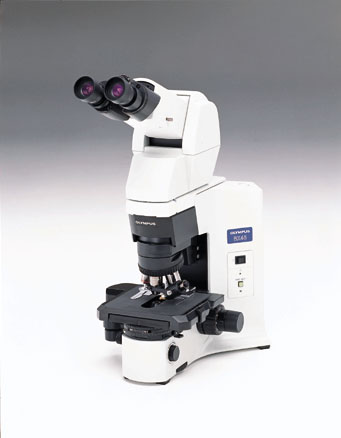
Figure 4: Designed for user comfort, the Olympus BX45 microscope featured a novel Y-shaped body
Still, in the 2000s, pathologists and researchers were given another tool in their toolbox with the ability to digitize whole slides using Olympus’ VS100 whole slide imaging (WSI) scanner. Digital images of slides could easily be shared with colleagues, facilitating collaborative analysis and telepathology (remote consultation and discussion).
Since 2010, Olympus has put design and functionality under the microscope, so to speak. New customer-focused features have been added to several microscope models. Olympus developed a LED light source that features high luminosity, true-to-life color, and an extended life of 50,000 hours, saving researchers money and downtime. The True Color LED technology was implemented in the BX 53, 43, and 46 microscopes.
The BX46 microscope exemplified Olympus’ commitment to user comfort. Every component involved in its operation was ergonomically designed. Innovative features, such as the moveable nosepiece and ultralow stage, helped ease the physical demands of repetitive routine microscopy. Olympus’ BX53 microscope for clinical pathology, launched in 2017, has illumination control functionality that synchronizes the brightness with the objective magnification. This provides yet another way to achieve more comfortable and less time-consuming microscopic observation.
Other notable innovations of the 2010s included:
- An interchangeable modular deck system for IX inverted microscopes, accommodating more diverse samples and a wider variety of life science applications.
- The launch of cellSens® image analysis software, featuring two modes: a simple and intuitive interface for clinical use and advanced parameters for high-end research image analysis.
- The FLUOVIEW 1200/1200-MPE laser scanning microscope was launched with an optimized optical design, enabling faster imaging and higher sensitivity than its predecessors.
100 Years of Proud Service to the Scientific Community
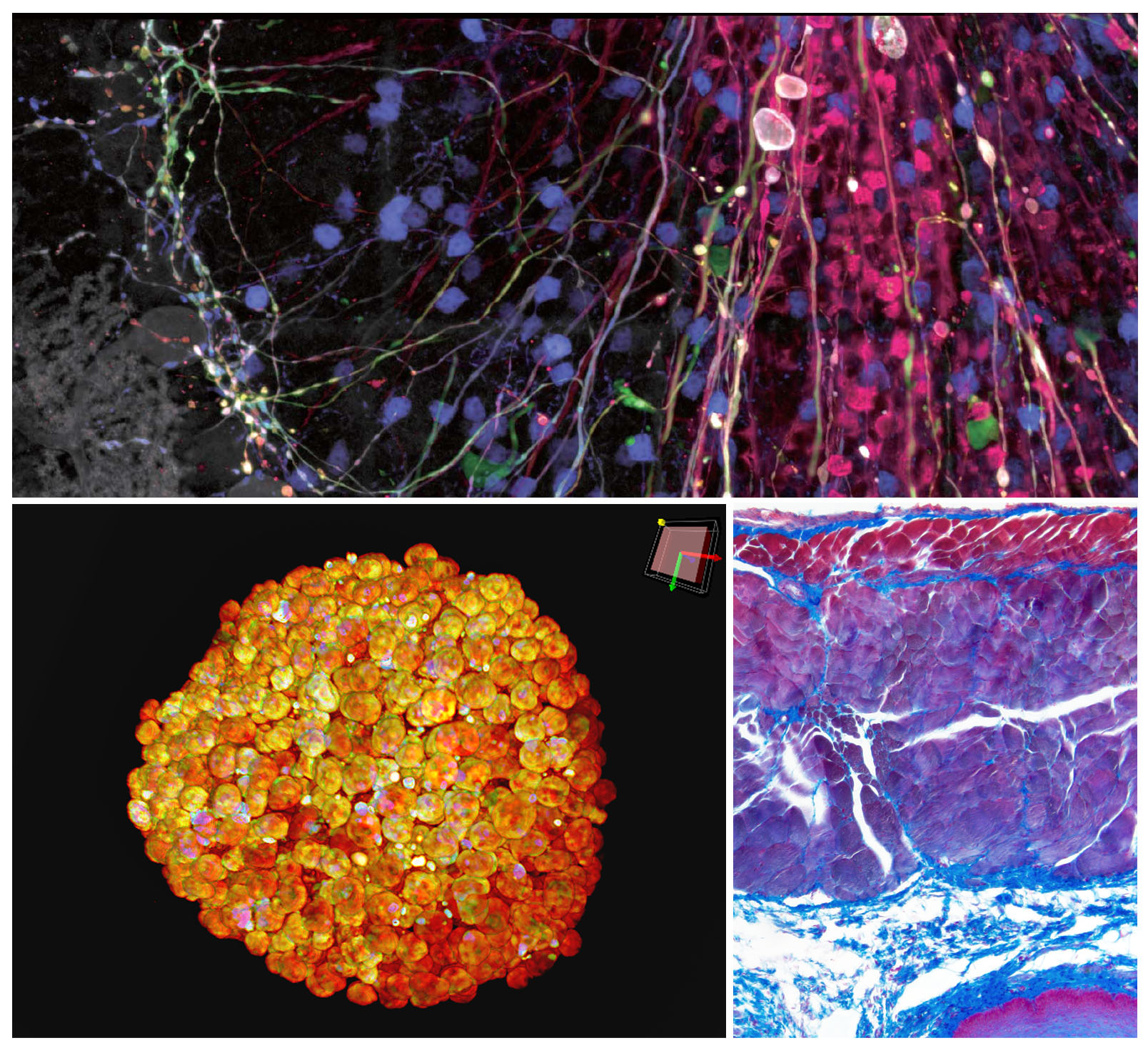
Figure 5: Top: Image of Brainbow AAV transfection of Purkinje cells, amplified with antibodies; Purkinje cell somata, dendrites, and axons are visible, as well as some aspecific stainings of granule cells acquired by the FV3000 microscope Bottom left: Cleared spheroid of HT-29 cells stained with DAPI (nuclear) acquired by the Olympus IXplore Spin system Bottom right: Azan stained captured by the DP74 digital microscope camera
Technological advances in this decade have significantly improved imaging speed and quality in the laboratory. For researchers, scientific CMOS (sCMOS) image sensors offering high quantum efficiency and super resolution microscopy have been enormously beneficial. In the clinical domain, turnaround time for laboratory testing has grown shorter as diagnoses are increasingly molecular and gene-based, which are less time consuming.
To meet the challenges faced by modern scientists, Olympus launched the FLUOVIEW FV3000 laser scanning confocal microscope in 2016. The FV3000 series features Olympus’ renowned high-quality optics, high-sensitivity, high-speed multichannel imaging with macro-to-micro capabilities, and a workflow-based intuitive user interface. The FV3000 frame is modular and flexible for varying applications and budgets, ranging from a simple, minimal configuration to fully customized advanced imaging.
A year later, Olympus introduced the IXplore™ system. Enabling researchers to choose the system best-suited for their observation needs, there are six IXplore configurations available: a standard model for simple documentation and five specialized options for motorized multidimensional observation, live cell imaging, TIRF (total internal reflection fluorescence), spinning disk confocal, and super resolution.
Going beyond the optical limit with super resolution has become the new reality in microscopy. Olympus Super Resolution (OSR) is available on the IXplore SpinSR10 microscope system. It has modes for widefield fluorescence, confocal imaging, and super resolution, enabling researchers to observe deeper into their specimens, faster and more easily.
Over the past century, Olympus technology has benefitted various applications with higher resolution and faster operation, which has helped revolutionize how science is approached and defined. Our researchers continue to develop and innovate imaging systems for both clinical and research laboratories, searching for faster, more powerful, and even more ergonomic solutions.
The creative spirit of our founder, Takeshi Yamashita, lives on in all of Olympus’ endeavors and is exemplified in our “True to Life” promise to deliver smart, innovative solutions that change the world around us and contribute to better society for all.
